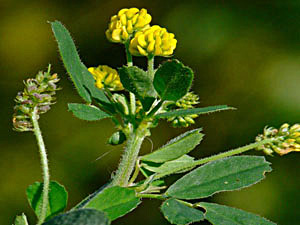
medicinal herbs
Black Medick
Medicago lupulina

Herb: Black Medick
Latin name: Medicago lupulina
Family: Leguminosae
Medicinal use of Black Medick:
Aqueous extracts of the plant have antibacterial properties against micro-organisms. The plant is lenitive.Description of the plant:

Plant:
Annual/Perennial
Height:
45 cm(1 foot)

Flowering:
April toAugust
Habitat of the herb:
Grassy places and roadsides, often occurring as a garden weed on acid and calcareous soils.Edible parts of Black Medick:
Leaves - cooked. Used as a potherb. A nutritional analysis is available. Seed - cooked. Parched and eaten or ground into a powder. The seed is said to contain trypsin inhibitors. These can interfere with certain enzymes that help in the digestion of proteins, but are normally destroyed if the seed is sprouted first.Other uses of the herb:
A good green manure plant, it is fairly deep rooted, has good resistance to "Clover rot" but it is not very fast growing. It can be undersown with cereals, succeeding even in a wet season.Propagation of Black Medick:
Pre-soak the seed for 12 hours in warm water and then sow in spring in situ. The seed can also be sown in situ in autumn. Green manure crops can be sown in situ from early spring until early autumn. (the later sowings are for an over-wintering crop)Cultivation of the herb:
Grassy places and roadsides, often occurring as a garden weed on acid and calcareous soils.Known hazards of Medicago lupulina:
None knownPlant information taken from the Plants For A Future.
